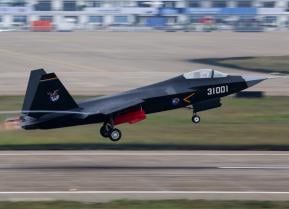Russia's Su-57 Stealth Fighter: Computer Flies, Pilot Fights?
The Su-57 has two large internal weapons bays arranged in tandem, which run nearly the entire useable length of the aircraft. Each of the bays can carry up to four K-77M beyond visual range radar-guided missiles.
Flying an advanced fighter aircraft requires that pilots multitask, but increasingly automation is taking over some of the more "mundane" aspects. And that means soon Russia's Sukhoi Su-57 stealth fighter will feature an automated system that will allow the pilot to focus on searching for and then attacking enemy targets while the aircraft handles the actual "piloting."
Su-57 Stealth Fighter: Computer Flies, Pilot Fights?
The fifth-generation, the single-seat multirole stealth fighter has received an updated cockpit system with "maximum degree of automated processes," the United Aircraft Corporation, which is part of the state high-tech conglomerate Rostec, told the New Horizons corporate magazine, as then reported by Tass. According to the reports, the upgraded Su-57 features increased automation of piloting and combat employment processes.
"Theoretically, the pilot may not engage in piloting after the take-off and until making an approach for landing and can instead focus on searching for and attacking targets," Head of the Cockpit Department of the Sukhoi Design Bureau within the UAC, Nikita Dorofeyev told the New Horizons magazine. "Moreover, this process is also sufficiently automated."
Dorofeyev added that automation, information integration, and intellectual support are the key requirements for the ergonomics of the cockpit of a modern fighter. The Russian-built fighter, which is only set to enter serial production this year, is also reported to be equipped with multifunctional indicators that can provide the pilot with information on the changing tactical situation as well as on the operation of the aircraft's systems.
The Su-57 also incorporates what Dorofeyev described as "technology of intellectual support," which can help the pilot accomplish assigned tasks.
Development on the advanced Su-57 began in 2002, but the aircraft only took its first flight on January 29, 2010. The Su-57 is essentially an evolution of the Su-27 Flanker's shape, modernized for low radar observability while providing even greater maneuverability. The Russian Air Force only took delivery of the first of the fifth-generation aircraft last year.
Su-57: How It Would Fight
The single-seat, twin-engine multirole fifth-generation Su-57 jet fighter was designed for air superiority and attack operations. The Su-57 can destroy all types of air, ground, and water-based targets. It was also the first Russian combat aircraft to utilize stealth technology, was also designed to have supercruise, supermaneuverability, and advanced avionics to overcome attacks from the prior generation fighter aircraft as well as ground and naval defenses. The aircraft also has supersonic cruise speed, internal weapons bays, radio-absorbing coating, and the newest onboard equipment.
The Su-57 has two large internal weapons bays arranged in tandem, which run nearly the entire useable length of the aircraft. Each of the bays can carry up to four K-77M beyond visual range radar-guided missiles. Compared to earlier versions of the K-77 (NATO nickname: AA-12 Archer) the K-77M missile has a larger body and active electronically-scanned array radar seeker, allowing it to engage highly agile targets at ranges of up to 100 miles. The aircraft also stores a pair of K-74M2 short-range infrared-guided missiles in underwing fairings.
Peter Suciu is a Michigan-based writer who has contributed to more than four dozen magazines, newspapers and websites. He regularly writes about military small arms, and is the author of several books on military headgear including A Gallery of Military Headdress, which is available on Amazon.com.


